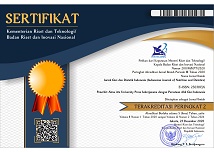Chronic energy malnutrition in mothers associated with stunting
Abstract
Background: Stunting is a nutritional problem that has a long-term impact. It has an impact on children's cognitive and physical development, serious infections, and makes a significant contribution to mortality and morbidity. According to WHO, the stunting rate in Indonesia is still high (30.8%). Maternal nutritional status contributes to fetal growth restriction which increases the risk of low birth weight and increases the risk of stunting.
Objectives: This study aims to determine the relationship between maternal nutritional status during pregnancy and stunting in children aged 6-23 months in Karawang Regency.
Methods: This study is an observational study with a cross-sectional design. The number of samples was 207 children aged 6-23 months in Srikamulyan village, Karawang regency. Data were collected using a structured questionnaire to determine the identity of the child, the identity of the mother, the nutritional status of the child, the history of the nutritional status of the mother during pregnancy, and sociodemographic data. Anthropometric measurements of the mother's height using a microtoise and the child's body length using a length board. Data were analyzed using univariate and bivariate analysis.
Results: The results showed that as many as 23.67% of children aged 6-23 months experienced stunting in Srikamulyan Village. Mothers who experience Chronic Energy Malnutrition during pregnancy as much as 8.2%. Data analysis showed that mothers with Chronic Energy Malnutrition during pregnancy were associated with stunting in children aged 6-23 months (p<0.05).
Conclusions: Chronic Energy Malnutrition during pregnancy is associated with the incidence of stunting in children aged 6-23 months. Prevention efforts from adolescent girls are an important key in improving the nutritional status of women of childbearing age and pregnant women in order to prevent stunting
Keywords
Full Text:
PDFReferences
Bomela NJ. Social, economic, health and environmental determinants of child nutritional status in three central asian republics. Public Health Nutr. 2009;12(10):1871–7.
World Health Organization. Guideline: updates on the management of severe acute malnutrition in infants and children. 2013.
UNICEF. The State of The Wolrd’s Children. New York: Oxford University Press; 1998.
World Health Organization. The double burden of malnutrition: policy brief. No. WHO/NMH/NHD/17.3. WHO 2016.
Black RE, Victora CG, Walker SP, Bhutta ZA, Christian P, De Onis M, et al. Maternal and child undernutrition and overweight in low-income and middle-income countries. Lancet. 2013;382(9890):427–51.
De Onis M, Onyango AW, Borghi E, Siyam A, Nishida C, Siekmann J. Development of a WHO growth reference for school-aged children and adolescents. Bull World Health Organ. 2007;85(9):660–7.
Black RE, Allen LH, Bhutta ZA, Caulfield LE, de Onis M, Ezzati M, et al. Maternal and child undernutrition: global and regional exposures and health consequences. Lancet. 2008;371(9608):243–60.
Bhutta ZA, Ahmed T, Black RE, Cousens S, Dewey K, Giugliani E, et al. What works? Interventions for maternal and child undernutrition and survival. Lancet. 2008;371(9610):417–40.
Dewey KG, Begum K. Long-term consequences of stunting in early life. Matern Child Nutr. 2011;7(SUPPL. 3):5–18.
Martorell R, Young MF. Patterns of Stunting and Wasting: Potential Explanatory Factors. Adv Nutr. 2012;3(2):227–233.
Badan Penelitian dan Pengembangan Kesehatan Kementerian Kesehatan RI. Riset Kesehatan Dasar. Jakarta; 2013.
Kementerian Kesehatan RI. Riset Kesehatan Dasar (Riskesdas) 2018. Jakarta; 2018.
Tim Nasional Percepatan Penanggulangan Kemiskinan (TNP2K). 100 Kabupaten/Kota Prioritas untuk Intervensi Anak Kerdil (Stunting): Tim Nasional Percepatan Penanggulangan Kemiskinan. Vol. 2, Jakarta. 2017.
Millenium Challenge Account. Stunting dan Masa Depan Indonesia. 2013.
Allen L. Nutritional influences on linear growth: a general review. Eur J Clin Nutr. 1994;48(Suppl 1):75–89.
Assis K, Botelho D, Marques D, Filardi C, Campos D, Saraiva A, et al. Nutrition influence on sow reproductive performance and conceptuses development and survival : A review about L -arginine supplementation. Livest Sci [Internet]. 2019;228(August):97–103. Available from: https://doi.org/10.1016/j.livsci.2019.08.010
Shiratori S. Determinant of Child Malnutrition in Tanzania: a Quantile Rgression Approach. Annu Meet Minneap Minnesota. 2014;
Kpewou DE, Poirot E, Berger J, Som SV, Laillou A, Belayneh SN, et al. Maternal mid-upper arm circumference during pregnancy and linear growth among Cambodian infants during the first months of life. Matern Child Nutr. 2020;16(S2):1–11.
Amaha ND, Woldeamanuel BT. Maternal factors associated with moderate and severe stunting in Ethiopian children: analysis of some environmental factors based on 2016 demographic health survey. Nutr J. 2021;20(1):1–9.
Fajrina N, Syaifudin. Hubungan Faktor Ibu Dengan Kejadian Stunting Pada Balita Di Puskesmas Piyungan Kabupaten Bantul. Fakultas Ilmu Kesehatan Universitas ’Aisyiyah Yogyakarta. 2016.
Elfrida E. Hubungan Riwayat Status Kesehatan Bayi Dan Status Gizi Ibu Hamil Terhadap Kejadian Stunted Pada Anak Usia 12-24 Bulan Di Wilayah Kerja Puskesmas Mersam Kabupaten Batang Hari Tahun 2015. Scien. 2015;4(3):222–30.
Sartono, Nurdiati DS. Hubungan Kurang Energi Kronis Ibu Hamil Dengan Kejadian Stunting pada Anak Usia 6-24 Bulan di Kota Yogyakarta. 2013.
Trihardiani I. Faktor Risiko Kejadian Berat Badan Lahir Rendah Di Wilayah Kerja Puskesmas Kingkawang Timur dan Utara Kota Singkawang. Program Studi Ilmu Gizi Fakultas Kedokteran Universitas Diponegoro. 2011.
Larasati DA, Nindya TS, Arief YS. Hubungan antara Kehamilan Remaja dan Riwayat Pemberian ASI Dengan Kejadian Stunting pada Balita di Wilayah Kerja Puskesmas Pujon Kabupaten Malang. Amerta Nutr. 2018;2(4):392.
Sukmaati, Hendrayati, Chaerunnimah, Nurhumaira. Status Gizi Ibu Saat Hamil, Berat Badan Lahir Bayi Dengan Stunting Pada Balita. Media Gizi Pangan. 2018;25:18–25.
Wellina WF, Kartasurya MI, Rahfiludin MZ. Faktor risiko stunting pada anak umur 12-24 bulan. J Gizi Indones (The Indones J Nutr. 2016;5(1):55–61.
DOI: http://dx.doi.org/10.21927/ijnd.2023.11(2).77-84
Refbacks
- There are currently no refbacks.

This work is licensed under a Creative Commons Attribution-ShareAlike 4.0 International License.
Indonesian Journal of Nutrition and Dietetics (IJND) indexed by:
 View My Stats
View My Stats



12.png)


























